Are you looking to create a harmonious and vibrant aquarium environment? Consider adding corydoras catfish and betta fish to your fish tank. Despite the betta’s reputation for aggression, these two species can actually coexist peacefully under the right conditions. In this article, we will explore the different types of corydoras catfish, the optimal tank conditions, and how to introduce them to your betta tank for a successful and serene cohabitation.
Core Insights to Corydoras and Betta Fish:
What Are Cory Catfish?
Corydoras catfish are small, hardy fish that originate from South America. These delightful creatures thrive in slow currents and are commonly found in rivers and streams with dense vegetation. Known for their peaceful nature, cory catfish make excellent tank mates for bettas.
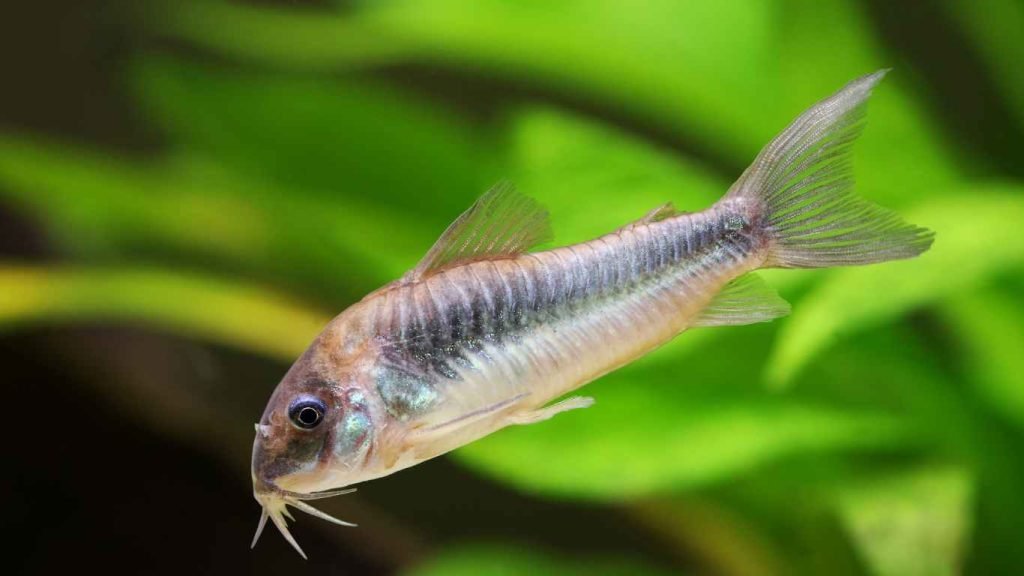
If you’re considering adding these charming South American fish to your aquarium, you’ll be delighted by their small size and ability to adapt to various conditions. Their hardiness and easy-to-care-for nature make them a favorite among fishkeepers of all levels of experience.
With their affinity for slow currents and their preference for densely vegetated habitats, cory catfish create a calming and natural aquascape in your tank. Watching these delightful fish leisurely explore their environment can provide hours of enjoyment and tranquility.
Whether you’re a beginner or an experienced fishkeeper, cory catfish are an ideal choice for adding personality and diversity to your tank. Let’s explore the fascinating world of cory catfish and learn more about their compatibility with bettas.
What Is the Temperament of The Corydoras Catfish?
When it comes to temperament, corydoras catfish are known for their peaceful nature. These delightful fish do not pose a threat to bettas and can coexist harmoniously with them in the same tank.
Corydoras catfish are social animals that tend to forage together at the bottom of the tank. Even when one takes a break, they stay close to their group, creating a sense of camaraderie and safety. Their preference for staying at the bottom of the tank makes them ideal companions for bettas, who mainly occupy the top and middle sections.
The peaceful nature of the corydoras catfish is an asset when it comes to keeping them with bettas, as it helps to reduce the likelihood of aggression and territorial conflicts. Both species can coexist happily, creating a vibrant and balanced aquatic environment.
These peaceful bottom-dwellers add a sense of tranquility to the tank, and their behavior is a joy to observe. They go about their activities in a non-disruptive manner, giving your betta fish a comfortable and stress-free environment to thrive in.
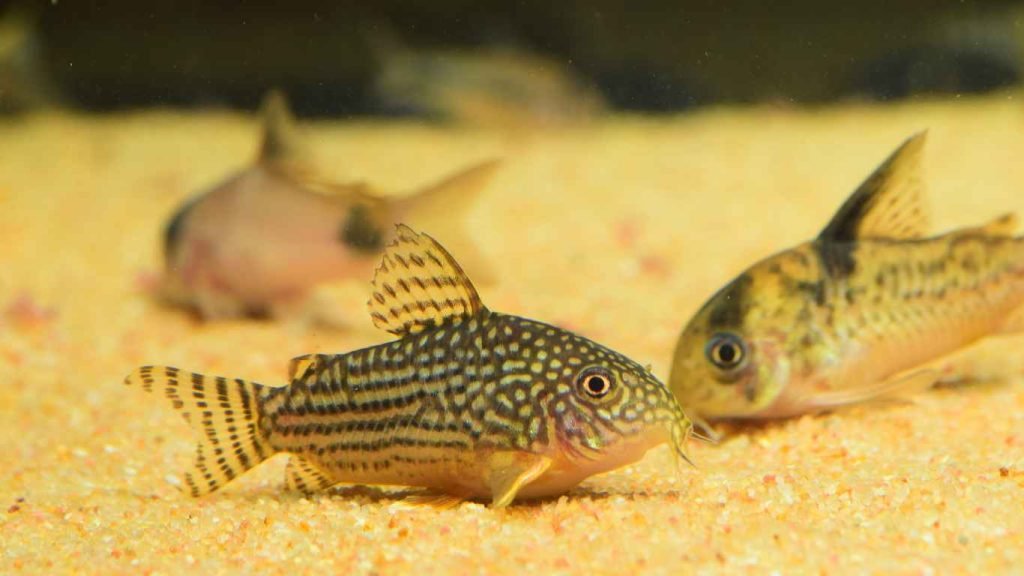
Overall, corydoras catfish’s peaceful temperament and compatibility with bettas make them an excellent choice for creating a harmonious and happy aquarium community.
Types of Cory Catfish
When it comes to corydoras catfish, there is a wide variety of species to choose from, each with its own unique characteristics. Here are some popular types of cory catfish that you can consider adding to your betta tank:
| Type of Cory Catfish | Description |
|---|---|
| Pygmy Corys | These small cory catfish species are adorable and perfect for smaller tanks. They have a peaceful nature and stay close to the bottom of the tank. |
| Bronze Cory | Known for their bronze-colored bodies, these cory catfish are a popular choice among aquarists. They are hardy and have a peaceful temperament. |
| Bandit Cory | With their black mask-like markings over their eyes, bandit cory catfish are both unique and eye-catching. They are peaceful and enjoy being in a group. |
| Julii Cory | Julii cory catfish are known for their intricate spotted patterns. They are peaceful and prefer to be kept in groups to feel more secure. |
| Leopard Cory | These cory catfish are named after their leopard-like spots. They are peaceful and make a delightful addition to your betta tank. |
| Peppered Cory | The peppered cory catfish has a pepper-like pattern on its body, hence the name. They are peaceful and enjoy foraging at the bottom of the tank. |
| Panda Corydoras Catfish | With its striking contrast of black and white colors, the panda corydoras catfish is a favorite among aquarists. They are peaceful and love being in a group. |
These different types of cory catfish offer a variety of colors, patterns, and sizes to choose from. Consider your tank size, compatibility with bettas, and the overall aesthetic you want to achieve when selecting the right cory catfish for your betta tank. Remember to provide a suitable environment for the specific species you choose to ensure their well-being.

What Are the Best Tank Conditions for Cory Catfish?
To create a thriving environment for your cory catfish, it is crucial to maintain stable tank conditions that support their well-being. Here are the key factors to consider:
- pH level: Cory catfish prefer a pH range between 7.0 and 7.8, which mimics the slightly alkaline water conditions of their natural habitat. This pH range ensures their optimal growth and overall health.
- Water temperature: Maintaining a water temperature between 70 and 78 degrees Fahrenheit is ideal for cory catfish. This range replicates their preferred tropical environment and promotes their vitality.
- Water parameters: Along with pH and temperature, it is essential to monitor other water parameters such as ammonia, nitrite, and nitrate levels regularly. Keeping these parameters in balance ensures a safe and healthy environment for your cory catfish.
- Plants: Cory catfish appreciates a well-planted tank with ample vegetation. Live plants not only enhance the aesthetics of the tank but also provide hiding spots and areas for foraging, contributing to their overall well-being.
- Substrate: Opt for a soft substrate, such as fine sand or smooth gravel, to protect the delicate barbels of your cory catfish. Avoid sharp or rough substrates that may cause injury or abrasion to their sensitive mouths.
By ensuring these tank conditions for your cory catfish, you can create a comfortable and natural habitat that fosters their health, happiness, and longevity.
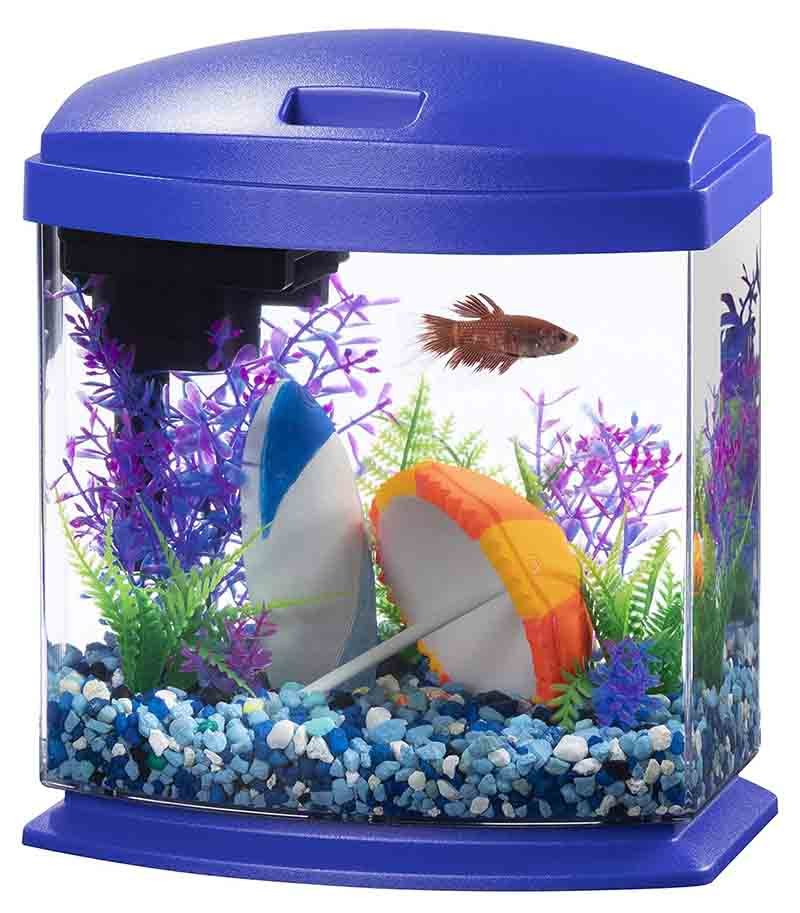
Small Aquarium Fish Tank Kit with SmartClean Technology
Can Cory Catfish Live with Betta Fish?
Yes, cory catfish can live with betta fish under the right circumstances. Cory catfish have a peaceful temperament that complements the aggressive nature of bettas. While bettas may see other flashy fish as threats, they typically do not view cory catfish as a threat. Additionally, both species have similar tank requirements in terms of pH and temperature, making it easier to create a harmonious environment for both.
How To House A Cory Catfish And Betta
When housing cory catfish and bettas together, it is important to provide an appropriate tank size and adequate filtration system. A minimum of 10 gallons is recommended to accommodate a group of cory catfish and a betta fish. Additionally, it is essential to have a cover on the tank to prevent accidental jumps, as both cory catfish and bettas have the potential to jump out of open aquariums.
Cory catfish, also known as corydoras, are social bottom-dwelling fish that require plenty of space to swim and explore. They are active and curious, so a larger tank size allows them to exhibit their natural behaviors. A spacious tank also provides each fish with their own territory, reducing the chances of aggression.
The cover on the tank serves as a protective barrier, preventing the cory catfish and betta fish from escaping. It is essential to choose a cover that allows for proper ventilation while still ensuring the safety of your aquatic pets.
Another crucial aspect of housing cory catfish and bettas is the filtration system. Both species produce waste that needs to be effectively filtered to maintain good water quality. A reliable filtration system will help remove debris, excess food, and harmful toxins, creating a healthy and thriving environment for your fish.
Remember to regularly monitor water parameters, perform routine water changes, and clean the tank to ensure optimal conditions for both the cory catfish and betta fish. By providing the right tank size, a secure cover, and a proper filtration system, you can create a harmonious and safe home for your cory catfish and betta.
| Factors to Consider | Requirements |
|---|---|
| Tank Size | Minimum of 10 gallons for a group of cory catfish and a betta fish |
| Cover | Ensure a secure cover to prevent jumps |
| Filtration System | Effective filtration system to maintain water quality |

How To Successfully Introduce Cory Catfish Into A Betta Tank
To successfully introduce cory catfish into a betta tank, it is recommended to make slight decorative changes to the tank before adding the cory catfish. This helps disrupt the betta’s dominant stance and reduces the chances of aggression towards the newcomers. It is also beneficial to add Indian almond leaves to the tank, as they mimic the natural habitat of bettas and help create a more comfortable environment.
Before introducing the cory catfish to the betta tank, consider rearranging the tank decor or adding new plants. This will create a fresh environment and prevent the established betta from perceiving the newcomers as intruders. Providing hiding spots and separate territories within the tank can also help minimize potential conflicts.
Indian almond leaves can be added to the tank to create a more natural and comfortable environment for both the betta and cory catfish. These leaves release tannins into the water, which helps mimic the blackwater conditions that bettas are accustomed to in their native habitats. The tannins also have a mild antibacterial effect, promoting the overall health of the fish.
Moreover to redecorating and adding Indian almond leaves, it is essential to monitor the tank closely during the initial introduction period. Watch for any signs of aggression or stress in either the betta or cory catfish. If necessary, provide additional hiding spots or consider separating the fish temporarily until they adjust and become more comfortable with each other.
Table: Tips for Introducing Cory Catfish to a Betta Tank
| Tip | Description |
|---|---|
| 1 | Make slight decorative changes to the tank |
| 2 | Add Indian almond leaves to the tank |
| 3 | Create hiding spots and separate territories |
| 4 | Monitor the tank closely during the introduction period |
By following these steps and providing a peaceful and comfortable environment, you can successfully introduce cory catfish to a betta tank, ensuring a harmonious coexistence between these two fish species.

Join Our GeoZoo Family
Subscribe to our Newsletter
Tips To Achieve A Peaceful Coexistence Between Betta Fish And Corydoras Catfish
Achieving a peaceful coexistence between betta fish and corydoras catfish requires careful consideration of various factors. By understanding the betta’s temperament, providing an adequate tank size, considering pygmy corydoras, and incorporating ample hiding spots, you can foster a harmonious environment for both species.
1. Observe Your Betta’s Behavior
Before introducing corydoras catfish to your betta tank, take the time to observe your betta’s temperament. Some bettas are more aggressive than others and may not be suitable tank mates for corydoras. Look for indicators of aggression, such as flaring, chasing, or fin nipping. Choosing tank mates that are compatible with your betta’s behavior is crucial for maintaining peace in the aquarium.
2. Provide a Larger Tank Size
Tank size plays a significant role in promoting a peaceful coexistence between bettas and corydoras catfish. Inadequate space can lead to territorial conflicts and increased stress levels. Providing a larger tank, such as a minimum of 20 gallons, allows both species to establish their territories and reduces the likelihood of aggression. A spacious tank also ensures proper swimming room for both bettas and corydoras.
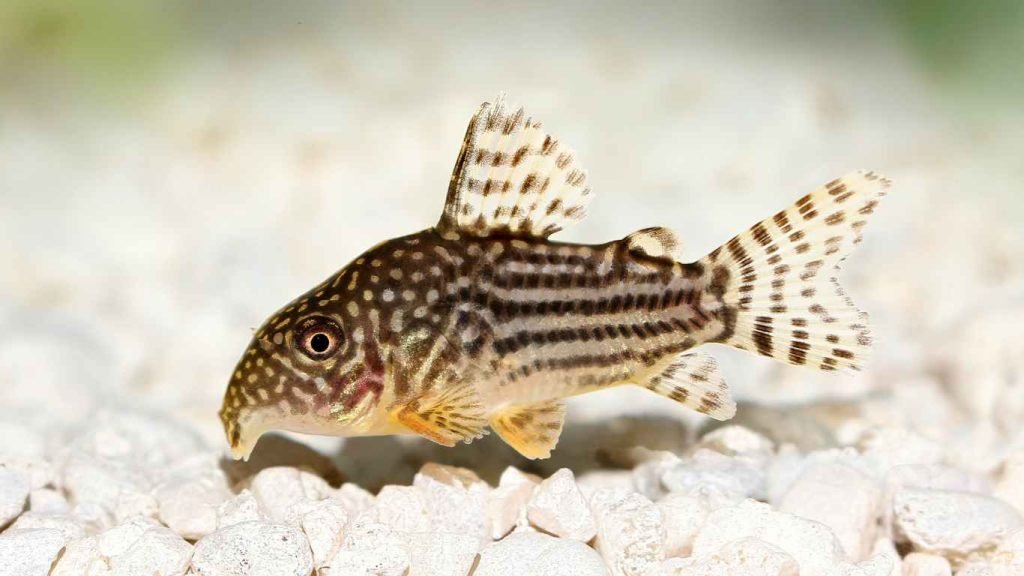
3. Consider Pygmy Corydoras
When choosing corydoras catfish for your betta tank, consider opting for pygmy corydoras. These smaller-sized corydoras species are less likely to provoke a betta’s aggressive instincts due to their diminutive size. Pygmy corydoras also tend to be more timid and prefer to stay closer to the bottom of the tank, minimizing interaction with the betta fish.
4. Feature Plenty of Hiding Spots
Creating an environment with ample hiding spots is essential for ensuring the well-being of both bettas and corydoras catfish. Hiding spots provide the corydoras with spaces to retreat and establish their territories away from the betta’s reach. You can include various elements such as caves, driftwood, and plants to offer multiple hiding options for your fish. The more hiding spots available, the more comfortable and secure both species will feel.
By taking these tips into consideration, you can increase the chances of achieving a peaceful coexistence between betta fish and corydoras catfish. Remember to always monitor the behavior of both species and make adjustments as necessary to maintain a harmonious aquarium environment.
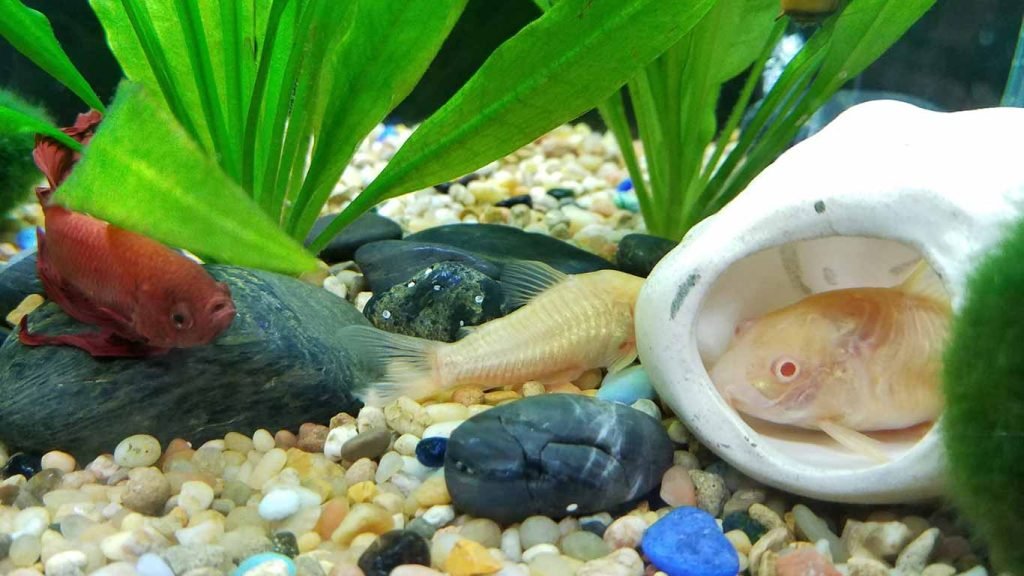
How To Select The Right Cory Catfish For Your Betta
When it comes to selecting a cory catfish to add to your betta tank, there are a few important factors to consider. Tank size, temperament, and compatibility are key elements that will help ensure a successful and harmonious coexistence between these two species.
Tank Size: Larger tank sizes are more suitable for larger cory catfish species, while smaller tank sizes can accommodate smaller cory catfish species. Providing enough space for each fish to establish their territory is crucial for their overall well-being and reduces the likelihood of aggression.
Temperament: It is essential to choose cory catfish with a peaceful temperament. The gentle and sociable nature of cory catfish makes them compatible tank mates for bettas. This temperament is less likely to trigger aggression in bettas, promoting a harmonious environment.
Compatibility: Consider the compatibility between the cory catfish and your betta fish. Some cory catfish species have specific care requirements and preferences. For example, some species prefer cooler water temperatures, while others thrive in slightly warmer conditions. Choosing cory catfish that have similar tank requirements to your betta will ensure they can coexist comfortably.
Common Cory Catfish Species
| Cory Catfish Species | Size | Temperament | Water Temperature |
|---|---|---|---|
| Pygmy Corys | Up to 1 inch | Peaceful | 70-77°F |
| Bronze Cory | Up to 2.5 inches | Peaceful | 68-77°F |
| Bandit Cory | Up to 3 inches | Peaceful | 72-79°F |
| Julii Cory | Up to 2.5 inches | Peaceful | 72-79°F |
| Leopard Cory | Up to 2.5 inches | Peaceful | 70-77°F |
| Peppered Cory | Up to 3 inches | Peaceful | 68-77°F |
| Panda Corydoras Catfish | Up to 2.5 inches | Peaceful | 72-79°F |
Consider the size, temperament, and water temperature requirements of different cory catfish species to select the right one for your betta tank. Paying attention to these factors will help ensure a compatible and peaceful coexistence between your cory catfish and betta fish.
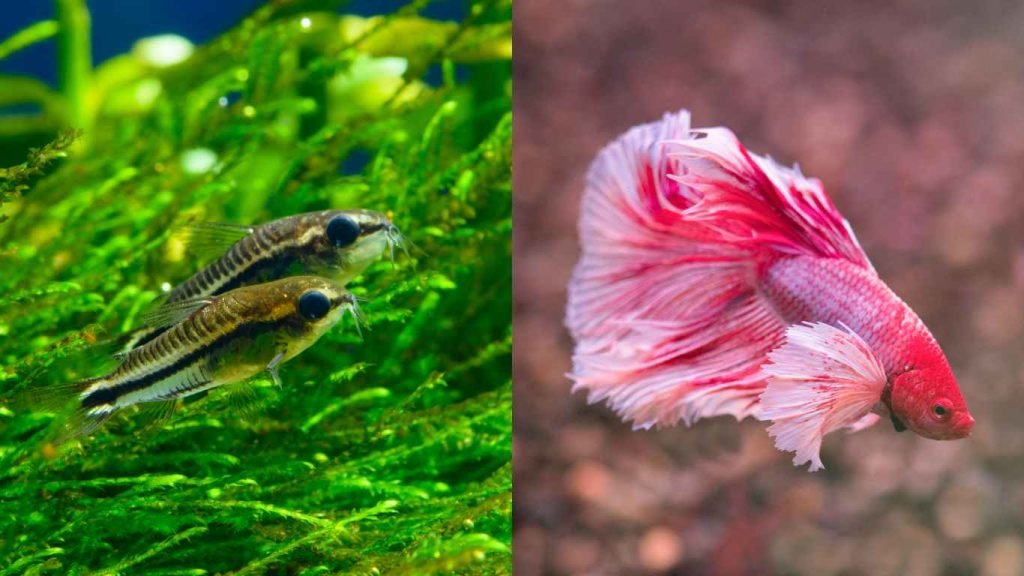
A Quick Comparison Between Cory Catfish and Betta
When considering cory catfish and betta fish as potential tank mates, it’s essential to understand their differences in temperament, water parameters, and tank behavior. This quick comparison will give you an overview of these distinct characteristics, helping you make an informed decision for your aquarium.
Cory Catfish
- Cory catfish are peaceful fish that prefer to dwell at the bottom of the tank.
- They are sociable and often found in groups, forging a sense of community.
While they are generally peaceful, it’s important to note that different species of cory catfish may have slight variations in behavior and temperament.
Betta Fish
- Betta fish can be territorial, often staking their claim in the top and middle water columns of the tank.
- They are known for their vibrant colors and flamboyant displays, which can intimidate other fish.
These aggressive tendencies are primarily directed towards flashy tank mates, which is an important consideration when introducing them to cory catfish.
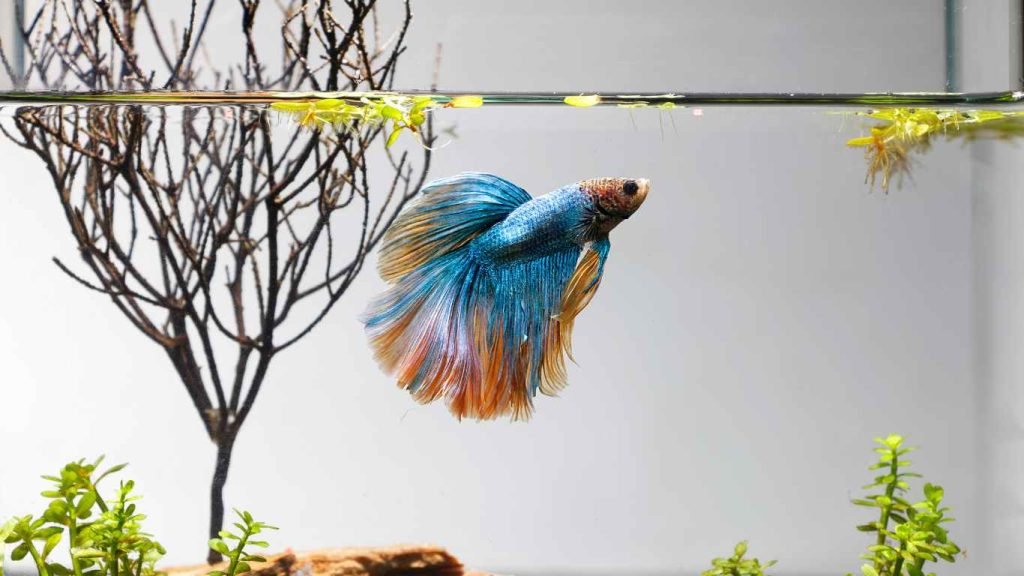
Coexistence
Despite their contrasting temperaments, cory catfish and betta fish can coexist peacefully under the right conditions:
- Providing ample space in the tank can help minimize any territorial conflicts between them.
- Maintaining suitable water parameters, such as pH and temperature, that meet the requirements of both species is crucial for their well-being.
- Creating an environment with plenty of hiding spots and plants can give each fish their own space and reduce potential stress.
By understanding the distinct characteristics of cory catfish and betta fish and taking the necessary steps to create a harmonious environment, you can successfully accommodate these beautiful fish in the same tank.
A Comparison of Cory Catfish and Betta
| Traits | Cory Catfish | Betta Fish |
|---|---|---|
| Temperament | Peaceful | Territorial |
| Preferred Tank Behavior | Bottom-dwelling | Top and middle water columns |
| Water Parameters | pH 7.0-7.8, 70-78°F | pH 6.0-7.5, 76-82°F |

Join Our GeoZoo Family
Subscribe to our Newsletter
Final Remarks
In the end, corydoras and betta fish can be peaceful tank mates when provided with the right conditions. Cory catfish, known for their peaceful nature, make excellent bottom-dwelling companions for bettas. By considering factors such as tank size, temperament, and tank conditions, you can create a harmonious environment for both species.
It is important to observe your betta’s behavior and choose the appropriate cory catfish species for compatibility. With their similar tank requirements in terms of pH and temperature, corydoras and betta fish can coexist without triggering aggression.
With proper care and attention, a combination of corydoras and betta fish in your aquarium can result in a vibrant and harmonious fishkeeping experience. By ensuring the right conditions are met and providing a suitable environment, you can enjoy the beauty of these peaceful tank mates and create a serene underwater world in your own home.
FAQ
What are cory catfish?
Cory catfish are small, hardy fish native to South America. They thrive in slow currents and are typically found in rivers and streams with dense vegetation.
What is the temperament of the corydoras catfish?
Corydoras catfish are peaceful and happy when kept with their own kind.
What are the types of cory catfish?
Some types of cory catfish include pygmy corys, bronze cory, bandit cory, Julii cory, leopard cory, peppered cory, and panda corydoras catfish.
What are the best tank conditions for cory catfish?
Cory catfish prefer a pH level between 7.0 and 7.8 and a water temperature between 70 and 78 degrees Fahrenheit. They also appreciate a well-planted tank with ample hiding spots and a soft substrate that won’t damage their barbels.
Can cory catfish live with betta fish?
Yes, cory catfish can live with betta fish. Cory catfish have a peaceful temperament that complements the aggressive nature of bettas. Both species have similar tank requirements in terms of pH and temperature, making it easier to create a harmonious environment for both.
How do I house a cory catfish and betta together?
When housing cory catfish and bettas together, it is important to provide an appropriate tank size and an adequate filtration system. A minimum of 10 gallons is recommended to accommodate a group of cory catfish and a betta fish. Additionally, it is essential to have a cover on the tank to prevent accidental jumps.
How do I successfully introduce cory catfish into a betta tank?
To successfully introduce cory catfish into a betta tank, it is recommended to make slight decorative changes to the tank before adding the cory catfish. This helps disrupt the betta’s dominant stance and reduces the chances of aggression towards the newcomers. Adding Indian almond leaves to the tank can also create a more comfortable environment.
What are some tips to achieve a peaceful coexistence between betta fish and corydoras catfish?
Tips to achieve a peaceful coexistence include considering the temperament of your betta, providing a larger tank size, considering pygmy corydoras, and featuring plenty of hiding spots.
How do I select the right cory catfish for my betta?
When selecting a cory catfish for your betta, consider factors such as tank size, temperament, and compatibility. Larger tank sizes are suitable for larger cory catfish species, while smaller tank sizes can accommodate smaller cory catfish species.
What are the differences between cory catfish and betta fish?
A quick comparison reveals differences in temperament, water parameters, and tank behavior between cory catfish and betta fish. Cory catfish are peaceful and bottom-dwelling, while betta fish can be territorial and occupy the top and middle water columns.

